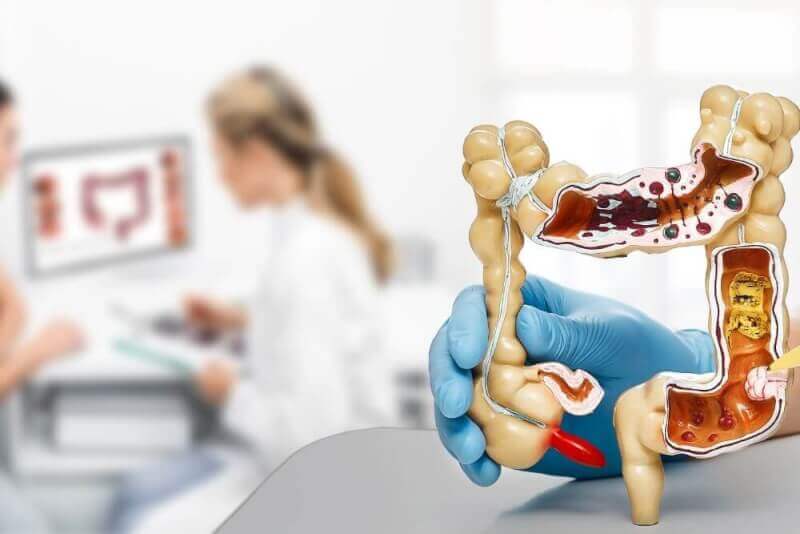What is an intestinal polyp?
Polyp is the name given to the bud-like structures that can occur at different points of the body and are caused by cells multiplying more than normal. Polyps, which can be seen in organs such as the nose, uterus and stomach, are also seen in the large intestine.
Intestinal polyps in the lining of the large intestine are usually harmless. However, if intestinal polyps are not under control and grow, this is an important risk factor for colon cancer.
Intestinal polyp diagnosis methods
Various screening tests are used to detect intestinal polyps, also called colon polyps. These tests provide a great advantage in diagnosing polyps before they become cancerous.
Colonoscopy
The most effective method for diagnosing polyps is colonoscopy. The inside of the large intestine is examined in detail with a flexible device with a camera on the end. Thanks to the high quality of the images taken in colonoscopy and the simultaneous reflection of the image on the screen, it is possible to examine the inner surface of the intestine in detail.
It also allows for immediate removal of polyps in the event that an intestinal polyp is found during colonoscopy. Immediate removal of polyps with the colonoscopy method, which allows the removal of fragments, is a great advantage for the patient's health.
Virtual colonoscopy
In a virtual colonoscopy, a contrast medium is first injected into the intestine. The presence of polyps in the intestine can then be detected by MRI or computed tomography. However, very small polyps are difficult to detect with this method. In addition, in the presence of polyps, patients will need to undergo colonoscopy to remove the polyps.
Flexible sigmoidoscopy
It is a diagnostic method in which the lower part of the colon and rectum are checked with a device with a light and camera.
Stool-based tests
Usually, the presence of blood cells in stool tests performed before a colonoscopy is considered an indication of a possible intestinal polyp.
Barium enema
Barium enema, an old method of diagnosing intestinal polyps, is no longer used frequently. For this test, the large intestine is first filled with barium and then the patient is x-rayed. However, with the discovery of methods such as colonoscopy, it is almost completely abandoned.
Causes of intestinal polyps
The main cause of intestinal polyps, a health problem that can occur in everyone, is not yet known. However, risk factors that lead to an increased risk of intestinal polyps are known. These factors include the following:
- Stress
- Excess weight
- Sedentary life
- 50 years of age or older
- Uncontrolled type 2 diabetes
- Cigarette smoking
- Gardner syndrome
- Family history of colon cancer
- Inflammatory bowel diseases such as ulcerative colitis
Symptoms of intestinal polyps
Intestinal polyps usually do not cause any symptoms. For this reason, it is usually discovered incidentally during routine examinations. On the other hand, the complaints encountered in symptomatic intestinal polyps include the following:
- Rectal bleeding
- Anemia
- Change in stool color
- Fatigue
- Shortness of breath
- Change in toilet habits
- Constipation or diarrhea lasting more than a week
- Belly pain
Symptoms of intestinal polyps do not necessarily mean colon cancer. In addition, some medications, especially hemorrhoids, cause complaints similar to the complaints mentioned above. For this reason, it is recommended to consult a specialist doctor in case of symptoms.
Intestinal polyp treatment methods
Treatment of intestinal polyps is only possible with surgical methods. The surgical method to be applied varies according to the number and type of polyps. The methods used to remove intestinal polyps are as follows.
Polypectomy
Wire loop or forceps are used to remove the polyp from the intestine. In cases where the polyps are larger than 1 centimeter, the procedure is performed after injecting liquid to remove the polyp from the surrounding tissues.
Minimally invasive surgery
It is a procedure applied to polyps that are too large to be removed in the colonoscopy procedure performed during the diagnosis of intestinal polyps. Large polyps can usually be removed laparoscopically.
Removal of colon and rectum
Removal of intestinal polyps seen in some hereditary diseases is also extremely important for the prevention of colon cancer. In this case, the colon and rectum must be completely removed. This procedure is called total proctocolectomy.
Types of intestinal polyps
There are two types of intestinal polyps. These varieties include the following:
Adenomatous polyps
Adenomatous polyps, also called adenoma polyps, are the most common type of polyp in the large intestine. It carries a higher risk of colon cancer than the other type. The risk of cancer varies depending on the number and size of the polyps. Adenoma polyps are also differentiated depending on their appearance under the microscope. These varieties include the following.
- Tubular adenoma
- Villous adenoma
- Tubovillous adenoma
Hyperplastic polyps
It is the second most common type of intestinal polyp. These polyps, which usually do not cause cancer, are usually smaller than 0.5 centimeters in size.
What do intestinal polyps look like?
The images of intestinal polyps under the microscope vary. Polyp images usually seen under a microscope are as follows:
- Tubular
- Serrated shape
- Without hair
- Without a handle
- Mushroom shaped
- Wide base and stemless
- Polyps that appear completely flat
What are the features of intestinal polyps that increase the risk of cancer?
Intestinal polyps have a risk of causing colon cancer. Symptoms that indicate an increased risk include the following:
- The radius of the polyps is over 1 centimeter
- Polyps are associated with genetic syndromes
- Finger-like appearance of the polyp
- Flat appearance of the polyp
- Presence of more than 2 polyps
- Findings of dysplasia in samples taken from the polyp












